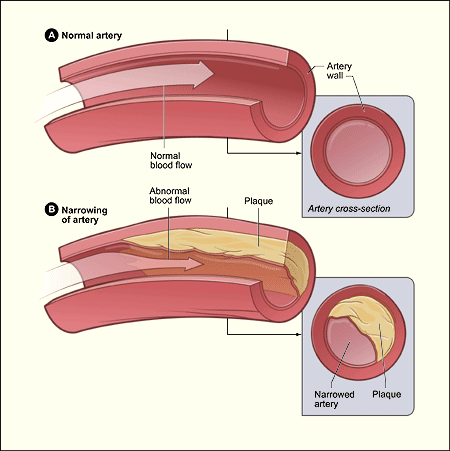

Atherosclerosis, often referred to as hardening of the arteries, is a progressive disease that develops when plaque, a sticky substance made up of fat, cholesterol, cellular waste products, calcium, and fibrin (a clotting material), builds up inside the walls of your arteries.
Here’s a closer look at atherosclerosis:The Culprit: Plaque Buildup
Plaque buildup narrows the arteries, reducing blood flow to your organs and tissues. This narrowing can lead to serious health problems like heart attack, stroke, and peripheral artery disease (PAD).Risk Factors:
Several factors contribute to the development of atherosclerosis, including:- High blood pressure
- High LDL (“bad”) cholesterol and low HDL (“good”) cholesterol
- Smoking
- Diabetes
- Obesity
- Physical inactivity
- Family history of atherosclerosis
Silent Threat :
Atherosclerosis often progresses slowly and without symptoms for many years. You may not experience any noticeable issues until the plaque buildup becomes severe enough to significantly obstruct blood flow.Diagnosis:
Various tests can help diagnose atherosclerosis, including:- Blood tests to measure cholesterol levels
- Ankle-brachial index (ABI) to assess blood flow in the legs
- Carotid artery ultrasound to check for plaque buildup in the neck arteries
- Echocardiogram to evaluate the heart’s function
- Coronary angiography (rarely used due to its invasive nature) to visualize the arteries
Treatment and Prevention:
- There’s no cure for atherosclerosis, but lifestyle changes and medications can effectively manage it and prevent further complications. Treatment strategies include:
- Lifestyle modifications: Quitting smoking, eating a heart-healthy diet, exercising regularly, and maintaining a healthy weight are crucial.
- Medications: Cholesterol-lowering medications (statins), blood pressure medications, and medications to prevent blood clots might be prescribed depending on your individual needs.
- Procedures: In severe cases, minimally invasive procedures like angioplasty and stenting or even bypass surgery might be needed to open narrowed arteries and improve blood flow.
Living With Atherosclerosis:
- Early detection and management of atherosclerosis are essential for preventing serious health complications.
- By following a healthy lifestyle and adhering to your doctor’s recommendations, you can effectively control atherosclerosis and live a long, healthy life.
Here are some additional points to remember:
- Atherosclerosis is a leading cause of cardiovascular disease, the biggest killer globally.
- Making healthy lifestyle choices and managing risk factors are key to preventing and controlling atherosclerosis.
- If you have any concerns about atherosclerosis, talk to your doctor for personalized advice.
